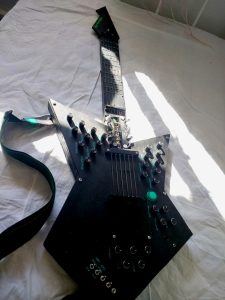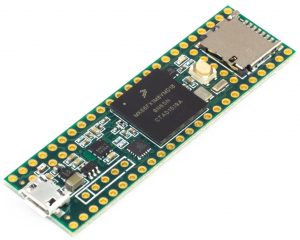 The creator, mattybrad, describes it as a synth-guitar hybrid that uses a Teensy 3.6 microcontroller, which is new to me. Basically, the instrument is played like a guitar,he says but produces sound like a synthesizer, using digital oscillators and effects. A conductive plectrum strums the invisible strings…
The creator, mattybrad, describes it as a synth-guitar hybrid that uses a Teensy 3.6 microcontroller, which is new to me. Basically, the instrument is played like a guitar,he says but produces sound like a synthesizer, using digital oscillators and effects. A conductive plectrum strums the invisible strings…
It was created as part of the Summer of Sound Challenge on RS Component’s Design Spark community site.
The way it works is that the Teensy reads each sensor on the fretboard to determine the user’s current finger positions. It also reads from each ‘string’ on the body to determine whether the metal plectrum is in contact with them. If it is, that string’s note is muted. If the plectrum has been released, then string’s note is sounded.
Finally, the MCU reads each potentiometer and toggle switch, and adjusts any audio parameters accordingly, he says.
“The guitar’s fretboard contains metal contacts in place of frets, which complete a circuit when the metal guitar strings are held down, therefore determining which chord or note will be played when the user strums the ‘strings’. To simulate the strumming/plucking action, there are six metal rods on the guitar’s body which, when contacted by the connected metal plectrum, complete a circuit and trigger the notes.”
To celebrate #NationalGuitarDay we wanted to take a moment to appreciate this awesome synthesizer-guitar hybrid instrument created by mattybrad on @DesignSparkRS. Find out more at: https://t.co/e7GZazebun #MusicTech #Guitar pic.twitter.com/OBWuA5cpae
— RS Components (@RSComponents) February 11, 2021
The Python code for this project can be found on GitHub. It’s a serious, involved project, as you can also see from the parts list enumerated.
 This is where the Teensy (right) strengths came into play, even though it was developed using the Arduino IDE. He writes:
This is where the Teensy (right) strengths came into play, even though it was developed using the Arduino IDE. He writes:
“The ‘cleverest’ part of the code in this project was happily already in existence: the Teensy audio library is a great set of audio sources and processes such as oscillators, amplifiers, filters, and mixers. These building blocks can be connected together in a dedicated online GUI which generates Arduino code. For this project, I designed an audio system in the GUI consisting of six identical virtual monophonic synthesizers, one for each string of the guitar, then exported the resulting code into an Arduino sketch.”
Very impressive. Check out this video:
[embed]https://www.youtube.com/watch?v=vw9rIkqk-Ic[/embed]
[ad_2]




0 Comments: